The AMD Ryzen 5 1600X vs Core i5 Review: Twelve Threads vs Four at $250
by Ian Cutress on April 11, 2017 9:00 AM ESTBenchmarking Performance: CPU Office Tests
The office programs we use for benchmarking aren't specific programs per-se, but industry standard tests that hold weight with professionals. The goal of these tests is to use an array of software and techniques that a typical office user might encounter, such as video conferencing, document editing, architectural modelling, and so on and so forth. At present we have two such tools to use.
PCMark8
Despite originally coming out in 2008/2009, Futuremark has maintained PCMark8 to remain relevant in 2017. On the scale of complicated tasks, PCMark focuses more on the low-to-mid range of professional workloads, making it a good indicator for what people consider 'office' work. We run the benchmark from the commandline in 'conventional' mode, meaning C++ over OpenCL, to remove the graphics card from the equation and focus purely on the CPU. PCMark8 offers Home, Work and Creative workloads, with some software tests shared and others unique to each benchmark set.
Chromium Compile (v56)
Our new compilation test uses Windows 10 Pro, VS Community 2015.3 with the Win10 SDK to combile a nightly build of Chromium. We've fixed the test for a build in late March 2017, and we run a fresh full compile in our test. Compilation is the typical example given of a variable threaded workload - some of the compile and linking is linear, whereas other parts are multithreaded.
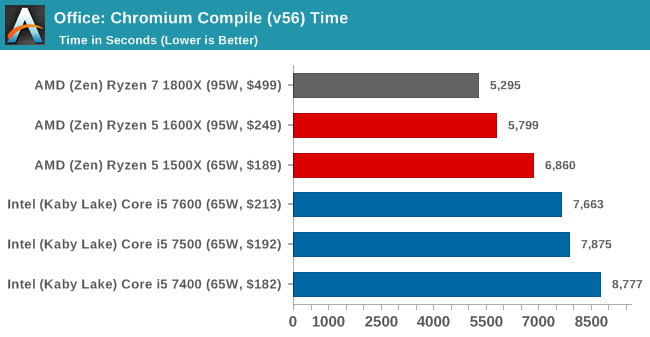
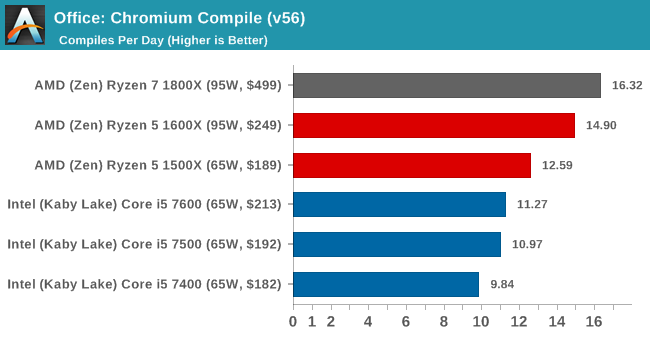
SYSmark 2014 SE
SYSmark is developed by Bapco, a consortium of industry CPU companies. The goal of SYSmark is to take stripped down versions of popular software, such as Photoshop and Onenote, and measure how long it takes to process certain tasks within that software. The end result is a score for each of the three segments (Office, Media, Data) as well as an overall score. Here a reference system (Core i3-6100, 4GB DDR3, 256GB SSD, Integrated HD 530 graphics) is used to provide a baseline score of 1000 in each test.
A note on contect for these numbers. AMD left Bapco in the last two years, due to differences of opinion on how the benchmarking suites were chosen and AMD believed the tests are angled towards Intel processors and had optimizations to show bigger differences than what AMD felt was present. The following benchmarks are provided as data, but the conflict of opinion between the two companies on the validity of the benchmark is provided as context for the following numbers.







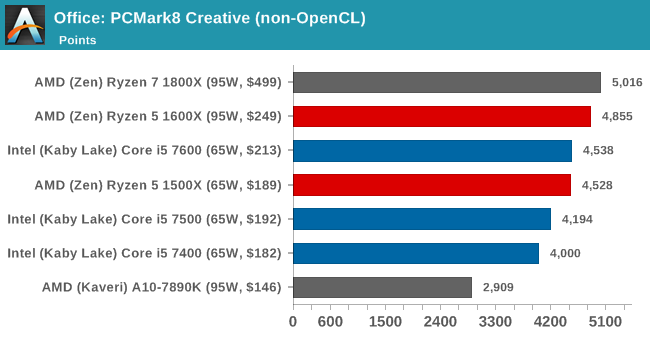
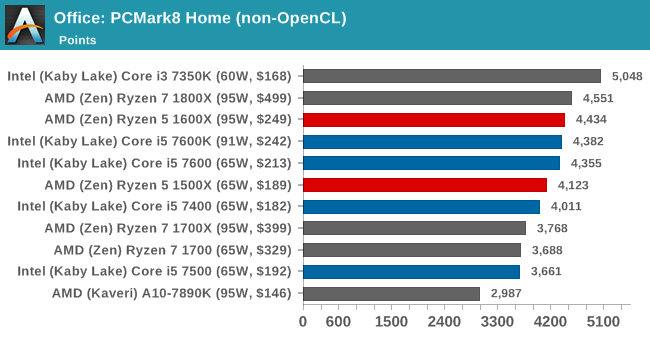
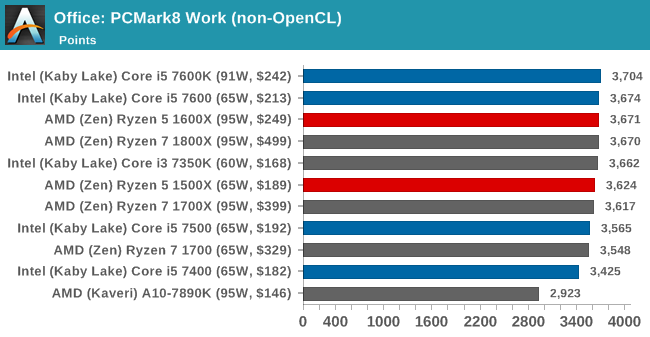








254 Comments
View All Comments
Meteor2 - Wednesday, April 12, 2017 - link
I think exact the same thing: R5 1600 + RX580 is going to be unbeatable value for money.deltaFx2 - Tuesday, April 11, 2017 - link
@Ian Cutress: It would be helpful to know whether any of the workloads above use AVX-256, just to know how prevalent they are in common code. For example, does your 3DPM code use AVX-256? Also, when you run legacy tests, are the binaries legacy too, or do you recompile when applicable?beerandcandy - Wednesday, April 12, 2017 - link
This looks like it might be a good start for AMD to get back in the game. This isn't the normal way you try to do these things. I think mostly you want to show your best CPU "DESTROY" the competitors best CPU. If AMD doesn't do that then it sucks because they wont be able to compete in the halo CPU product areas. This will also cause them to be in a limited market space and they will be forced into less profitable situationspandemonium - Wednesday, April 12, 2017 - link
I am curious why comparable Intel 2011-3 CPUs weren't included? The i7-6800k would be in nearly direct competition to the 1800X based on cores and MSRP.ET - Wednesday, April 12, 2017 - link
Thanks for the comprehensive testing. I was missing some Core i7 results for comparison in some tests, such as the compilation test.Lechelou - Wednesday, April 12, 2017 - link
Leonard Nimoy voiced Civ IV, not V. Just sayin'.madwolfchin - Wednesday, April 12, 2017 - link
Someone at AMD should rethink about the position of R7 1700 vs R5 1600X, The 1600X is faster in Single Tread, and about even with the 1700 in multi-threaded application. Why would anyone buy the 1700 which is much more expensiveOutlander_04 - Wednesday, April 12, 2017 - link
Because you can OC it and have the same performance as an 1800XMeteor2 - Wednesday, April 12, 2017 - link
I've only read as far as the test-bed set-up page: I want to say a MASSIVE thank you to MSI for supplying the GTX1080s. Top stuff, and that won't be forgotten.Back to reading...
vladx - Wednesday, April 12, 2017 - link
Wow so Anandtech have now turned into AMD shills. Not only you conveniently excluded or ignored the 7700k, but also skipped the 7600k from the gaming benchmarks to paint Ryzen in a better light than reality actually reflects.I understand you had to finish the article ASAP but Anandtech was all about quality articles and you really should've published the article when you had all the facts.